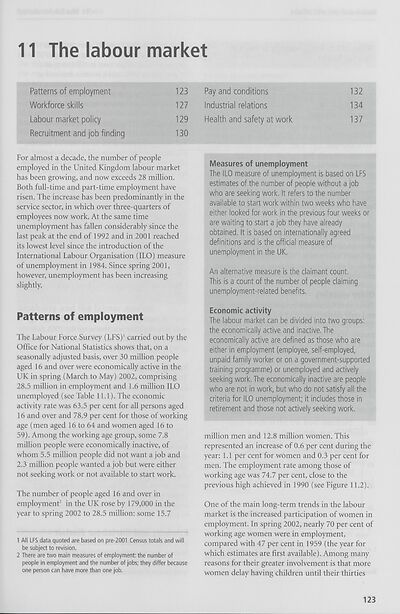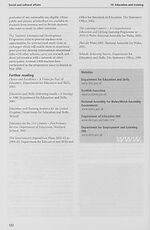Download files
Complete book:
Individual page:
Thumbnail gallery: Grid view | List view

11 The labour market
Patterns of employment 123
Workforce skills 127
Labour market policy 129
Recruitment and job finding 130
Pay and conditions 132
Industrial relations 134
Health and safety at work 137
For almost a decade, the number of people
employed in the United Kingdom labour market
has been growing, and now exceeds 28 million.
Both full-time and part-time employment have
risen. The increase has been predominantly in the
service sector, in which over three-quarters of
employees now work. At the same time
unemployment has fallen considerably since the
last peak at the end of 1992 and in 2001 reached
its lowest level since the introduction of the
International Labour Organisation (ILO) measure
of unemployment in 1984. Since spring 2001,
however, unemployment has been increasing
slightly.
Patterns of employment
The Labour Force Survey (LFS)1 2 carried out by the
Office for National Statistics shows that, on a
seasonally adjusted basis, over 30 million people
aged 16 and over were economically active in the
UK in spring (March to May) 2002, comprising
28.5 million in employment and 1.6 million ILO
unemployed (see Table 11.1). The economic
activity rate was 63.5 per cent for all persons aged
16 and over and 78.9 per cent for those of working
age (men aged 16 to 64 and women aged 16 to
59). Among the working age group, some 7.8
million people were economically inactive, of
whom 5.5 million people did not want a job and
2.3 million people wanted a job but were either
not seeking work or not available to start work.
The number of people aged 16 and over in
employment-1 in the UK rose by 179,000 in the
year to spring 2002 to 28.5 million: some 15.7
1 All LFS data quoted are based on pre-2001 Census totals and will
be subject to revision.
2 There are two main measures of employment: the number of
people in employment and the number of jobs; they differ because
one person can have more than one job.
Measures of unemployment
The ILO measure of unemployment is based on LFS
estimates of the number of people without a job
who are seeking work. It refers to the number
available to start work within two weeks who have
either looked for work in the previous four weeks or
are waiting to start a job they have already
obtained. It is based on internationally agreed
definitions and is the official measure of
unemployment in the UK.
An alternative measure is the claimant count.
This is a count of the number of people claiming
unemployment-related benefits.
Economic activity
The labour market can be divided into two groups:
the economically active and inactive. The
economically active are defined as those who are
either in employment (employee, self-employed,
unpaid family worker or on a government-supported
training programme) or unemployed and actively
seeking work. The economically inactive are people
who are not in work, but who do not satisfy all the
criteria for ILO unemployment; it includes those in
retirement and those not actively seeking work.
million men and 12.8 million women. This
represented an increase of 0.6 per cent during the
year: 1.1 per cent for women and 0.3 per cent for
men. The employment rate among those of
working age was 74.7 per cent, close to the
previous high achieved in 1990 (see Figure 11.2).
One of the main long-term trends in the labour
market is the increased participation of women in
employment. In spring 2002, nearly 70 per cent of
working age women were in employment,
compared with 47 per cent in 1959 (the year for
which estimates are first available). Among many
reasons for their greater involvement is that more
women delay having children until their thirties
123
Patterns of employment 123
Workforce skills 127
Labour market policy 129
Recruitment and job finding 130
Pay and conditions 132
Industrial relations 134
Health and safety at work 137
For almost a decade, the number of people
employed in the United Kingdom labour market
has been growing, and now exceeds 28 million.
Both full-time and part-time employment have
risen. The increase has been predominantly in the
service sector, in which over three-quarters of
employees now work. At the same time
unemployment has fallen considerably since the
last peak at the end of 1992 and in 2001 reached
its lowest level since the introduction of the
International Labour Organisation (ILO) measure
of unemployment in 1984. Since spring 2001,
however, unemployment has been increasing
slightly.
Patterns of employment
The Labour Force Survey (LFS)1 2 carried out by the
Office for National Statistics shows that, on a
seasonally adjusted basis, over 30 million people
aged 16 and over were economically active in the
UK in spring (March to May) 2002, comprising
28.5 million in employment and 1.6 million ILO
unemployed (see Table 11.1). The economic
activity rate was 63.5 per cent for all persons aged
16 and over and 78.9 per cent for those of working
age (men aged 16 to 64 and women aged 16 to
59). Among the working age group, some 7.8
million people were economically inactive, of
whom 5.5 million people did not want a job and
2.3 million people wanted a job but were either
not seeking work or not available to start work.
The number of people aged 16 and over in
employment-1 in the UK rose by 179,000 in the
year to spring 2002 to 28.5 million: some 15.7
1 All LFS data quoted are based on pre-2001 Census totals and will
be subject to revision.
2 There are two main measures of employment: the number of
people in employment and the number of jobs; they differ because
one person can have more than one job.
Measures of unemployment
The ILO measure of unemployment is based on LFS
estimates of the number of people without a job
who are seeking work. It refers to the number
available to start work within two weeks who have
either looked for work in the previous four weeks or
are waiting to start a job they have already
obtained. It is based on internationally agreed
definitions and is the official measure of
unemployment in the UK.
An alternative measure is the claimant count.
This is a count of the number of people claiming
unemployment-related benefits.
Economic activity
The labour market can be divided into two groups:
the economically active and inactive. The
economically active are defined as those who are
either in employment (employee, self-employed,
unpaid family worker or on a government-supported
training programme) or unemployed and actively
seeking work. The economically inactive are people
who are not in work, but who do not satisfy all the
criteria for ILO unemployment; it includes those in
retirement and those not actively seeking work.
million men and 12.8 million women. This
represented an increase of 0.6 per cent during the
year: 1.1 per cent for women and 0.3 per cent for
men. The employment rate among those of
working age was 74.7 per cent, close to the
previous high achieved in 1990 (see Figure 11.2).
One of the main long-term trends in the labour
market is the increased participation of women in
employment. In spring 2002, nearly 70 per cent of
working age women were in employment,
compared with 47 per cent in 1959 (the year for
which estimates are first available). Among many
reasons for their greater involvement is that more
women delay having children until their thirties
123
Set display mode to:
![]() Universal Viewer |
Universal Viewer | ![]() Mirador |
Large image | Transcription
Mirador |
Large image | Transcription
The item on this page appears courtesy of Office for National Statistics and may be re-used under the Open Government Licence for Public Sector Information.
| Britain and UK handbooks > UK: The official yearbook of the United Kingdom of Great Britain and Northern Ireland > 2003 > (145) |
|---|
| Permanent URL | https://digital.nls.uk/204924992 |
|---|
| Attribution and copyright: |
|
|---|---|
| Description | Three volumes of 'UK: The official yearbook of the United Kingdom of Great Britain and Northern Ireland', published annually by the Office of National Statistics from 2002-2005. |
|---|---|
| Shelfmark | GII.11 SER |
| Description | Three titles produced by the British Government from 1954-2005 describing 'how Britain worked'. They are: 'Britain: An official handbook' (1954-1998), 'Britain: The official yearbook of the United Kingdom' (1999-2001), and 'UK: The official yearbook of the United Kingdom of Great Britain and Northern Ireland' (2002-2005). These 50 reports provide an overview of Britain's economic, social and cultural affairs, its environment, international relations, and the systems of government. They give an impartial summary of government policies and initiatives, and explain how public services are organised. |
|---|---|
| Additional NLS resources: |
|

